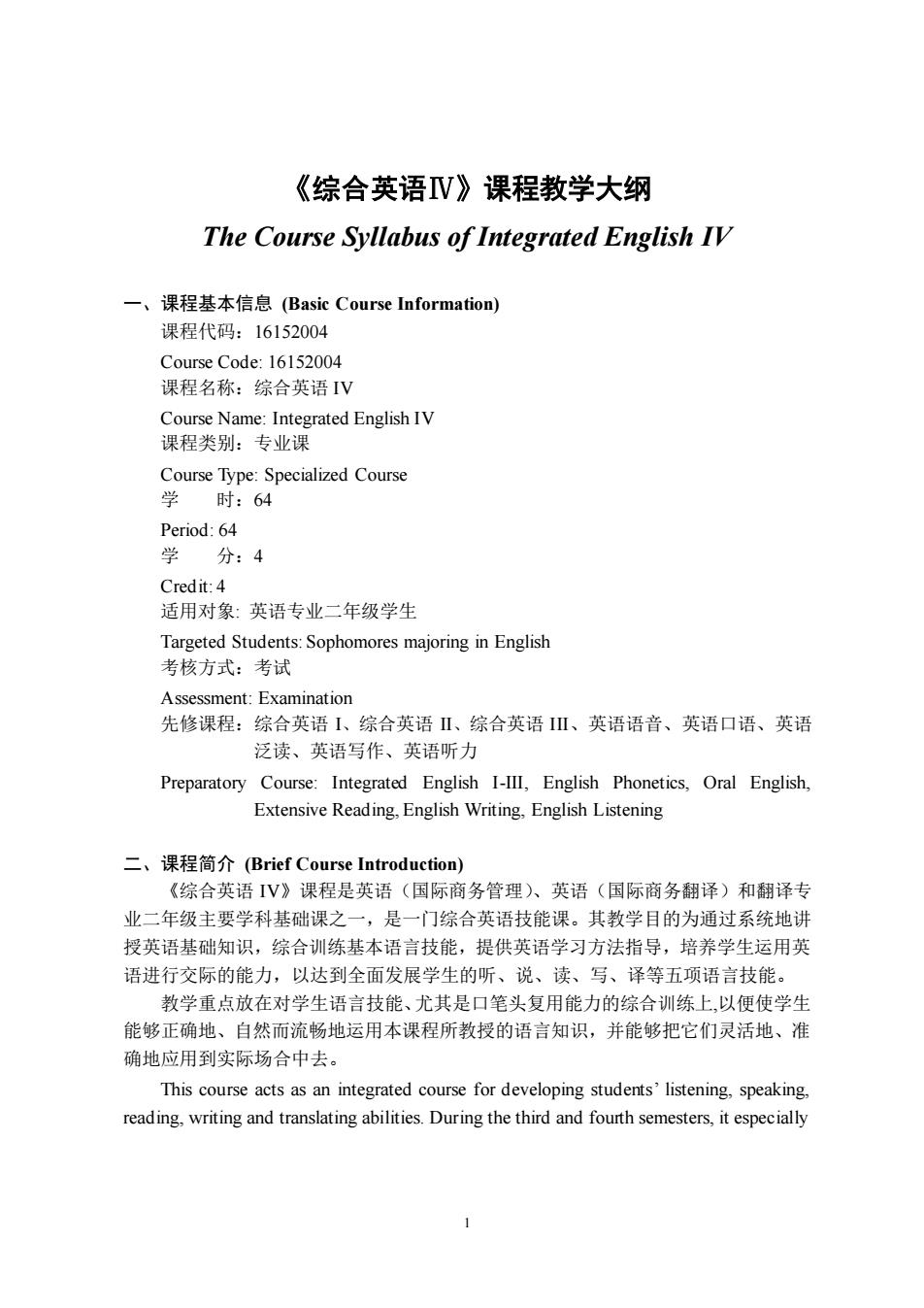
《综合英语V》课程教学大纲 The Course Syllabus of Integrated English IV 一、课程基本信息(Basic Course Information) 课程代码:16152004 Course Code:16152004 课程名称:综合英语IV Course Name:Integrated EnglishIV 课程类别:专业课 Course Type:Specialized Course 学时:64 Period:64 学分:4 Credit:4 适用对象:英语专业二年级学生 Targeted Students:Sophomores majoring in English 考核方式:考试 Assessment:Examination 先修课程:综合英语1、综合英语Ⅱ、综合英语Ⅲ、英语语音、英语口语、英语 泛读、英语写作、英语听力 Preparatory Course:Integrated English I-III,English Phonetics,Oral English Extensive Reading,English Writing,English Listening 二、课程简介(Brief Course Introduction) 《综合英语IV》课程是英语(国际商务管理)、英语(国际商务翻译)和翻译专 业二年级主要学科基础课之一,是一门综合英语技能课。其教学目的为通过系统地讲 授英语基础知识,综合训练基本语言技能,提供英语学习方法指导,培养学生运用英 语进行交际的能力,以达到全面发展学生的听、说、读、写、译等五项语言技能。 教学重点放在对学生语言技能、尤其是口笔头复用能力的综合训练上,以便使学生 能够正确地、自然而流畅地运用本课程所教授的语言知识,并能够把它们灵活地、准 确地应用到实际场合中去。 This course acts as an integrated course for developing students'listening,speaking. reading.writing and translating abilities.During the third and fourth semesters,it especially
1 《综合英语Ⅳ》课程教学大纲 The Course Syllabus of Integrated English IV 一、课程基本信息 (Basic Course Information) 课程代码:16152004 Course Code: 16152004 课程名称:综合英语 IV Course Name: Integrated English IV 课程类别:专业课 Course Type: Specialized Course 学 时:64 Period: 64 学 分:4 Credit: 4 适用对象: 英语专业二年级学生 Targeted Students: Sophomores majoring in English 考核方式:考试 Assessment: Examination 先修课程:综合英语 I、综合英语 II、综合英语 III、英语语音、英语口语、英语 泛读、英语写作、英语听力 Preparatory Course: Integrated English I-III, English Phonetics, Oral English, Extensive Reading, English Writing, English Listening 二、课程简介 (Brief Course Introduction) 《综合英语 IV》课程是英语(国际商务管理)、英语(国际商务翻译)和翻译专 业二年级主要学科基础课之一,是一门综合英语技能课。其教学目的为通过系统地讲 授英语基础知识,综合训练基本语言技能,提供英语学习方法指导,培养学生运用英 语进行交际的能力,以达到全面发展学生的听、说、读、写、译等五项语言技能。 教学重点放在对学生语言技能、尤其是口笔头复用能力的综合训练上,以便使学生 能够正确地、自然而流畅地运用本课程所教授的语言知识,并能够把它们灵活地、准 确地应用到实际场合中去。 This course acts as an integrated course for developing students’ listening, speaking, reading, writing and translating abilities. During the third and fourth semesters, it especially
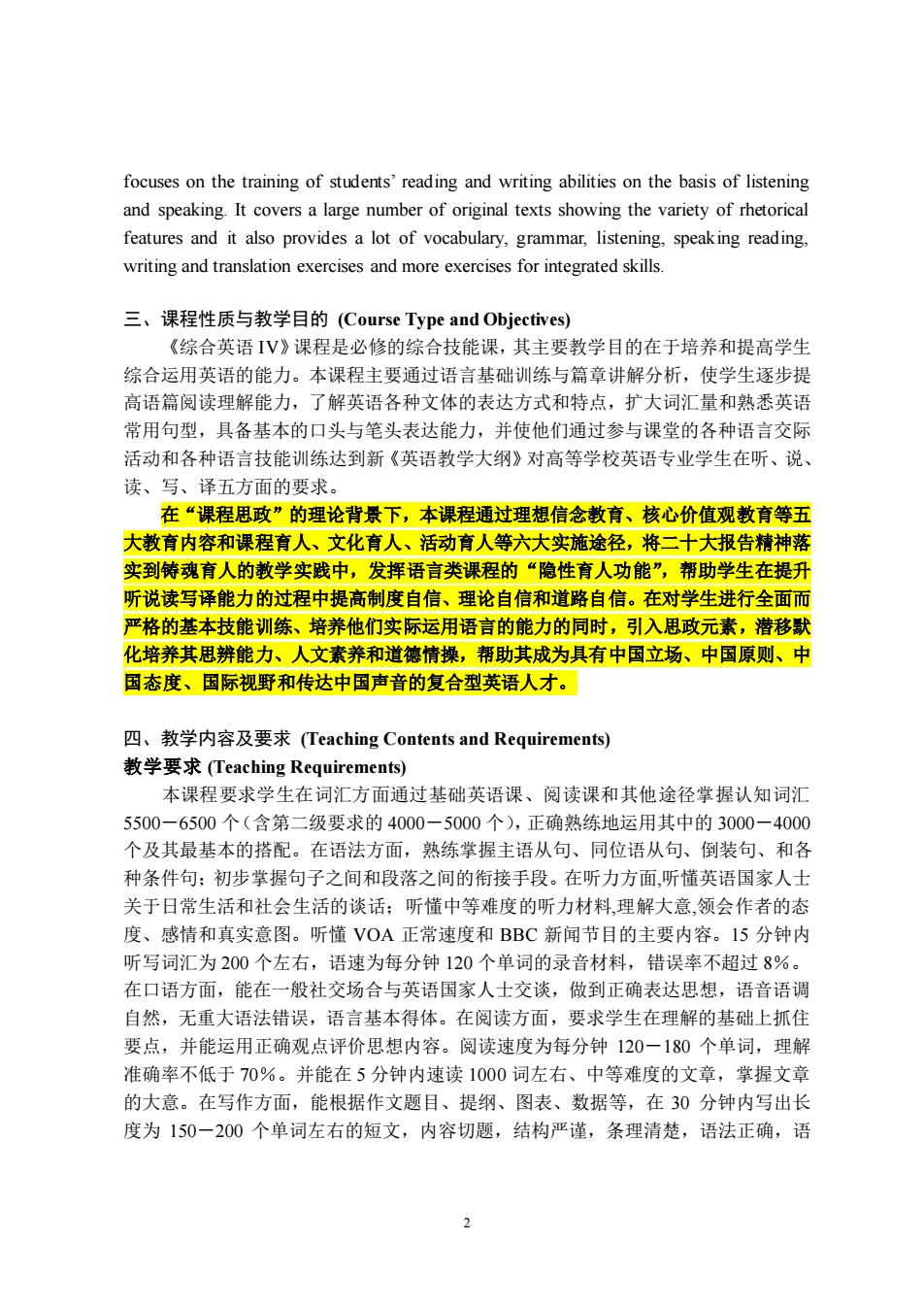
focuses on the training of students'reading and writing abilities on the basis of listening and speaking.It covers a large number of original texts showing the variety of rhetorical features and it also provides a lot of vocabulary,grammar,listening.speaking reading writing and translation exercises and more exercises for integrated skills. 三、课程性质与教学目的(Course Type and Objectives) 《综合英语V》课程是必修的综合技能课,其主要教学目的在于培养和提高学生 综合运用英语的能力。本课程主要通过语言基础训练与篇章讲解分析,使学生逐步提 高语篇阅读理解能力,了解英语各种文体的表达方式和特点,扩大词汇量和熟悉英语 常用句型,具备基本的口头与笔头表达能力,并使他们通过参与课堂的各种语言交际 活动和各种语言技能训练达到新《英语教学大纲》对高等学校英语专业学生在听、说、 读、写、译五方面的要求。 在“课程思政”的理论背景下,本课程通过理想信念教育、核心价值观教育等五 大教育内容和课程育人、文化育人、活动育人等六大实施途径,将二十大报告精神落 实到诗魂育人的敕学实践中,发挥语言类课程的“隐性育人功能”,帮助学生在提升 听说读写译能力的过程中提高制度自信、理论自信和道路自信。在对学生进行全面而 匹格的基本技能训练、培养他们实际运用语言的能力的同时,引入思政元素,潜移默 化培养其思辨能力、人文素养和道德情操,帮助其成为具有中国立场、中国原则、中 国态度、国际视野和传达中国声音的复合型英语人才。 四、教学内容及要求(Teaching Contents and Requirements) 教学要求(Teaching Requirements) 本课程要求学生在词汇方面通过基础英语课、阅读课和其他途径掌握认知词汇 5500一6500个(含第二级要求的4000一5000个),正确熟练地运用其中的3000一4000 个及其最基本的搭配。在语法方面,熟练掌握主语从句、同位语从句、倒装句、和各 种条件句:初光堂握句子之间和段落之间的衔接手段。在听力方面听懂英语国家人 关于日常生活和社会生活的谈话:听懂中等难度的听力材料,理解大意,领会作者的态 度、感情和真实意图。听懂VOA正常速度和BBC新闻节目的主要内容。15分钟内 听写词汇为200个左右,语速为每分钟120个单词的录音材料,错误率不超过8%。 在口语方面,能在一般社交场合与英语国家人士交谈,做到正确表达思想,语音语调 自然,无重大语法错误,语言基本得体。在阅读方面,要求学生在理解的基础上抓住 要点,并能运用正确观点评价思想内容。阅读速度为每分钟120一180个单词,理解 准确率不低于70%。并能在5分钟内速读1000词左右、中等难度的文章,掌握文章 的大意。在写作方面,能根据作文题目、提纲、图表、数据等,在30分钟内写出长 度为150一200个单词左右的短文,内容切题,结构严谨,条理清楚,语法正确,语 2
2 focuses on the training of students’ reading and writing abilities on the basis of listening and speaking. It covers a large number of original texts showing the variety of rhetorical features and it also provides a lot of vocabulary, grammar, listening, speaking reading, writing and translation exercises and more exercises for integrated skills. 三、课程性质与教学目的 (Course Type and Objectives) 《综合英语 IV》课程是必修的综合技能课,其主要教学目的在于培养和提高学生 综合运用英语的能力。本课程主要通过语言基础训练与篇章讲解分析,使学生逐步提 高语篇阅读理解能力,了解英语各种文体的表达方式和特点,扩大词汇量和熟悉英语 常用句型,具备基本的口头与笔头表达能力,并使他们通过参与课堂的各种语言交际 活动和各种语言技能训练达到新《英语教学大纲》对高等学校英语专业学生在听、说、 读、写、译五方面的要求。 在“课程思政”的理论背景下,本课程通过理想信念教育、核心价值观教育等五 大教育内容和课程育人、文化育人、活动育人等六大实施途径,将二十大报告精神落 实到铸魂育人的教学实践中,发挥语言类课程的“隐性育人功能”,帮助学生在提升 听说读写译能力的过程中提高制度自信、理论自信和道路自信。在对学生进行全面而 严格的基本技能训练、培养他们实际运用语言的能力的同时,引入思政元素,潜移默 化培养其思辨能力、人文素养和道德情操,帮助其成为具有中国立场、中国原则、中 国态度、国际视野和传达中国声音的复合型英语人才。 四、教学内容及要求 (Teaching Contents and Requirements) 教学要求 (Teaching Requirements) 本课程要求学生在词汇方面通过基础英语课、阅读课和其他途径掌握认知词汇 5500-6500 个(含第二级要求的 4000-5000 个),正确熟练地运用其中的 3000-4000 个及其最基本的搭配。在语法方面,熟练掌握主语从句、同位语从句、倒装句、和各 种条件句;初步掌握句子之间和段落之间的衔接手段。在听力方面,听懂英语国家人士 关于日常生活和社会生活的谈话;听懂中等难度的听力材料,理解大意,领会作者的态 度、感情和真实意图。听懂 VOA 正常速度和 BBC 新闻节目的主要内容。15 分钟内 听写词汇为 200 个左右,语速为每分钟 120 个单词的录音材料,错误率不超过 8%。 在口语方面,能在一般社交场合与英语国家人士交谈,做到正确表达思想,语音语调 自然,无重大语法错误,语言基本得体。在阅读方面,要求学生在理解的基础上抓住 要点,并能运用正确观点评价思想内容。阅读速度为每分钟 120-180 个单词,理解 准确率不低于 70%。并能在 5 分钟内速读 1000 词左右、中等难度的文章,掌握文章 的大意。在写作方面,能根据作文题目、提纲、图表、数据等,在 30 分钟内写出长 度为 150-200 个单词左右的短文,内容切题,结构严谨,条理清楚,语法正确,语
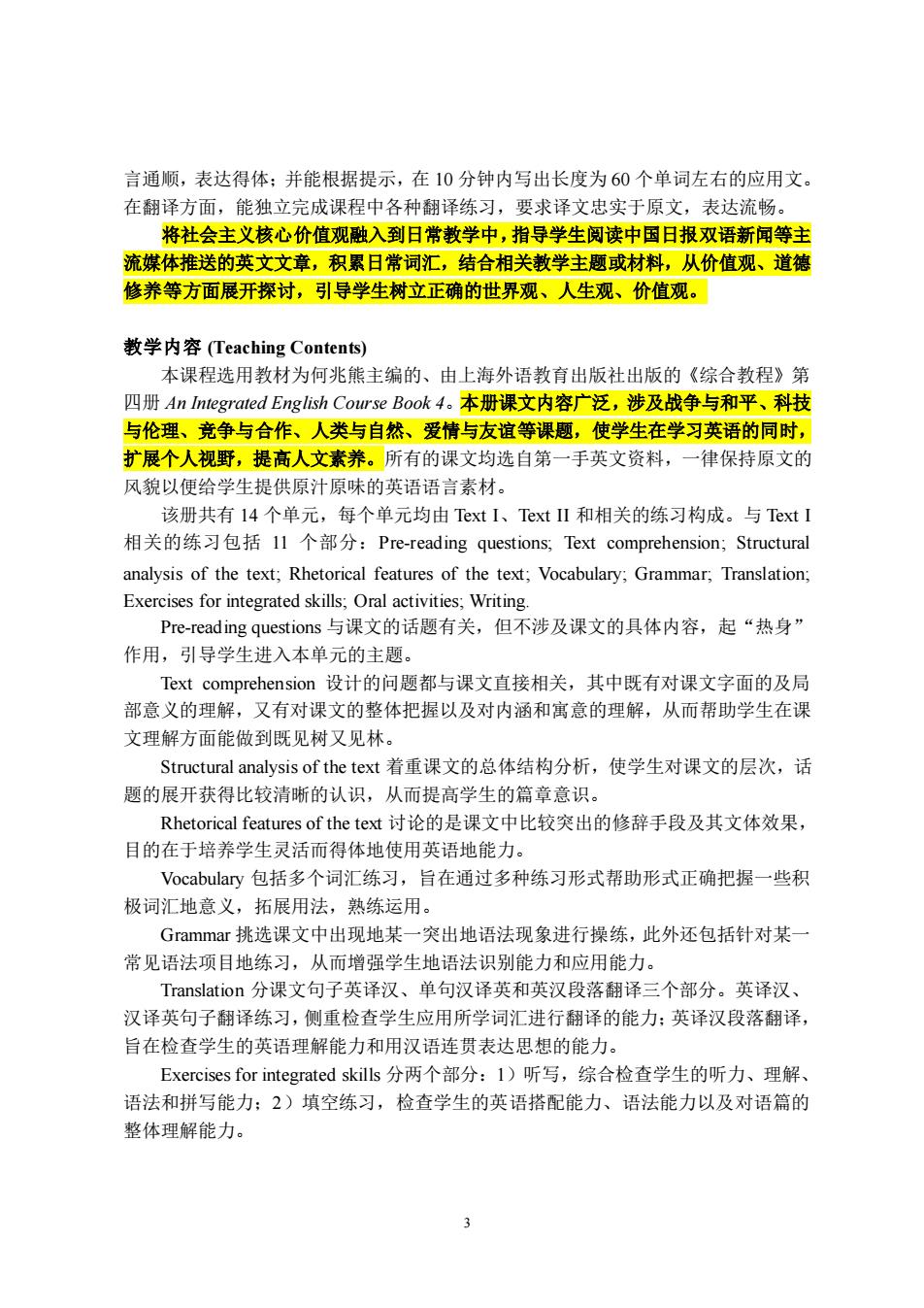
言通顺,表达得体:并能根据提示,在10分钟内写出长度为60个单词左右的应用文。 在翻译方面,能独立完成课程中各种翻译练习,要求译文忠实于原文,表达流畅 将社会主义核心价值观融入到日常教学中,指导学生阅读中国日报双语新闻等主 流媒体推送的英文文章,积累日常词汇,结合相关教学主题或材料,从价值观、道德 修养等方面展开探讨,引导学生树立正确的世界观、人生观、价值观。 教学内容(Teaching Contents) 本课程选用教材为何兆熊主编的、由上海外语教育出版社出版的《综合教程》第 四册An Integrated English Course Book4。本册课文内容广泛,涉及战争与和平、科技 与伦理、竞争与合作、人类与自然、爱情与友谊等课题,使学生在学习英语的同时, 扩展个人视野,提高人文素养。所有的课文均选自第一手英文资料, 一律保特原文的 风貌以便给学生提供原汁原味的英语语言素材。 该册共有l4个单元,每个单元均由Text I、TextⅡ和相关的练习构成。与Text I 相关的练习包括ll个部分:Pre-reading questions,.Text comprehension;Structural analysis of the text:Rhetorical features of the text:Vocabulary:Grammar.Translation: Exercises for integrated skills;Oral activities;Writing. Pre-reading questions与课文的话题有关,但不涉及课文的具体内容,起“热身” 作用,引导学生进入本单元的主题。 Text comprehension设计的问题都与课文直接相关,其中既有对课文字面的及局 部意义的理解,又有对课文的整体把握以及对内涵和寓意的理解,从而帮助学生在课 文理解方面能做到既见树又见林。 Structural analysis of the text着重课文的总体结构分析,使学生对课文的层次,话 题的展开获得比较清晰的认识,从而提高学生的篇章意识 Rhetorical features of the text讨论的是课文中比较突出的修辞手段及其文体效果, 目的在于培养学生灵活而得体地使用英语地能力。 Vocabulary包括多个词汇练习,旨在通过多种练习形式帮助形式正确把握一些积 极词汇地意义,拓展用法,熟练运用。 Grammar挑选课文中出现地某一突出地语法现象进行操练,此外还包括针对某一 常见语法项目地练习,从而增强学生地语法识别能力和应用能力。 Translation分课文句子英译汉、单句汉译英和英汉段落翻译三个部分。英译汉、 汉译英句子翻译练习,侧重检查学生应用所学词汇进行翻译的能力:英译汉段落翻译, 旨在检查学生的英语理解能力和用汉语连贯表达思想的能力。 Exercises for integrated skills分两个部分:l)听写,综合检查学生的听力、理解、 语法和拼写能力:2)填空练习,检查学生的英语搭配能力、语法能力以及对语篇的 整体理解能力。 3
3 言通顺,表达得体;并能根据提示,在 10 分钟内写出长度为 60 个单词左右的应用文。 在翻译方面,能独立完成课程中各种翻译练习,要求译文忠实于原文,表达流畅。 将社会主义核心价值观融入到日常教学中,指导学生阅读中国日报双语新闻等主 流媒体推送的英文文章,积累日常词汇,结合相关教学主题或材料,从价值观、道德 修养等方面展开探讨,引导学生树立正确的世界观、人生观、价值观。 教学内容 (Teaching Contents) 本课程选用教材为何兆熊主编的、由上海外语教育出版社出版的《综合教程》第 四册 An Integrated English Course Book 4。本册课文内容广泛,涉及战争与和平、科技 与伦理、竞争与合作、人类与自然、爱情与友谊等课题,使学生在学习英语的同时, 扩展个人视野,提高人文素养。所有的课文均选自第一手英文资料,一律保持原文的 风貌以便给学生提供原汁原味的英语语言素材。 该册共有 14 个单元,每个单元均由 Text I、Text II 和相关的练习构成。与 Text I 相关的练习包括 11 个部分:Pre-reading questions; Text comprehension; Structural analysis of the text; Rhetorical features of the text; Vocabulary; Grammar; Translation; Exercises for integrated skills; Oral activities; Writing. Pre-reading questions 与课文的话题有关,但不涉及课文的具体内容,起“热身” 作用,引导学生进入本单元的主题。 Text comprehension 设计的问题都与课文直接相关,其中既有对课文字面的及局 部意义的理解,又有对课文的整体把握以及对内涵和寓意的理解,从而帮助学生在课 文理解方面能做到既见树又见林。 Structural analysis of the text 着重课文的总体结构分析,使学生对课文的层次,话 题的展开获得比较清晰的认识,从而提高学生的篇章意识。 Rhetorical features of the text 讨论的是课文中比较突出的修辞手段及其文体效果, 目的在于培养学生灵活而得体地使用英语地能力。 Vocabulary 包括多个词汇练习,旨在通过多种练习形式帮助形式正确把握一些积 极词汇地意义,拓展用法,熟练运用。 Grammar 挑选课文中出现地某一突出地语法现象进行操练,此外还包括针对某一 常见语法项目地练习,从而增强学生地语法识别能力和应用能力。 Translation 分课文句子英译汉、单句汉译英和英汉段落翻译三个部分。英译汉、 汉译英句子翻译练习,侧重检查学生应用所学词汇进行翻译的能力;英译汉段落翻译, 旨在检查学生的英语理解能力和用汉语连贯表达思想的能力。 Exercises for integrated skills 分两个部分:1)听写,综合检查学生的听力、理解、 语法和拼写能力;2)填空练习,检查学生的英语搭配能力、语法能力以及对语篇的 整体理解能力
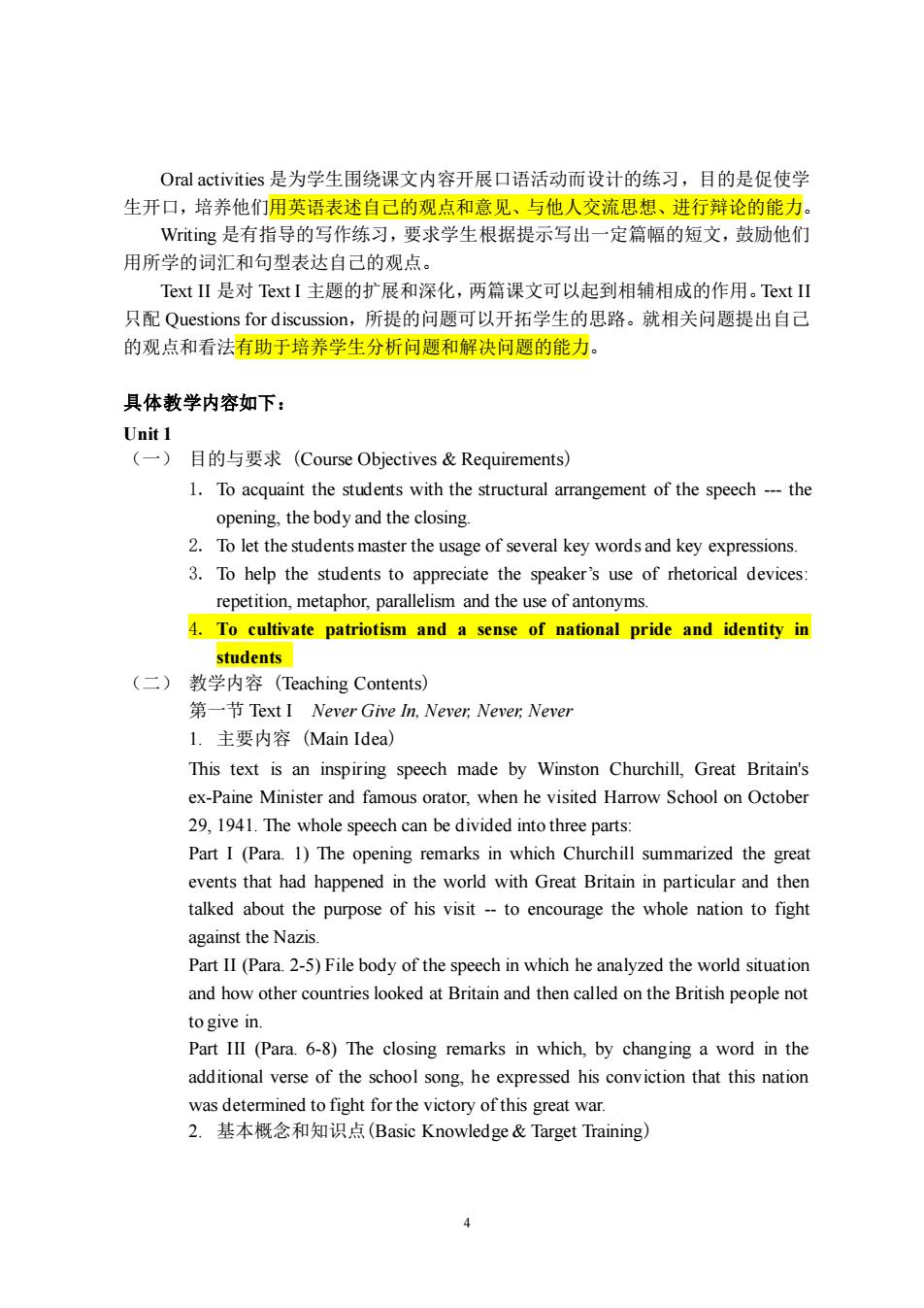
Oral activities是为学生围绕课文内容开展口语活动而设计的练习,目的是促使学 生开口,培养他们用英语表述自己的观点和意见、与他人交流思想、进行辩论的能力, Writing是有指导的写作练习,要求学生根据提示写出一定篇幅的短文,鼓励他们 用所学的词汇和句型表达自己的观点。 TextⅡ是对TextI主题的扩展和深化,两篇课文可以起到相辅相成的作用。TextIⅡ 只配Questions for discussion,所提的问题可以开拓学生的思路。就相关问题提出自己 的观点和看法有助于培养学生分析问题和解决问题的能力。 具体教学内容如下: Unit1 (一)目的与要求(Course Objectives&Requirements)) 1.To acquaint the students with the structural arrangement of the speech--the opening,the body and the closing. 2.To let the students master the usage of several key words and key expressions. 3.To help the students to appreciate the speaker's use of rhetorical devices repetition,metaphor,parallelism and the use of antonyms. 4.To cultivate patriotism and a sense of national pride and identity in students (二) 教学内容(Teaching Contents, 第一节Text I Never Give In.Never:Never Never .主要内容(Main Idea) This text is an inspiring speech made by Winston Churchill,Great Britain's ex-Paine Minister and famous orator.when he visited Harrow School on October 29,1941.The whole speech can be divided into three parts Part i (Para.1)The opening remarks in which Churchill summarized the great events that had happened in the world with Great Britain in particular and ther talked about the purpose of his visit--to encourage the whole nation to fight against the Nazis. Part II (Para.2-5)File body of the speech in which he analyzed the world situation and how other countries looked at Britain and then called on the British people not to give in. Part III (Para.6-8)The closing remarks in which,by changing a word in the additional verse of the school song,he expressed his conviction that this nation was determined to fight for the victory of this great wa 2.基本概念和知识点(Basic Knowledge&Target Training) 4
4 Oral activities 是为学生围绕课文内容开展口语活动而设计的练习,目的是促使学 生开口,培养他们用英语表述自己的观点和意见、与他人交流思想、进行辩论的能力。 Writing 是有指导的写作练习,要求学生根据提示写出一定篇幅的短文,鼓励他们 用所学的词汇和句型表达自己的观点。 Text II 是对 Text I 主题的扩展和深化,两篇课文可以起到相辅相成的作用。Text II 只配 Questions for discussion,所提的问题可以开拓学生的思路。就相关问题提出自己 的观点和看法有助于培养学生分析问题和解决问题的能力。 具体教学内容如下: Unit 1 (一) 目的与要求 (Course Objectives & Requirements) 1. To acquaint the students with the structural arrangement of the speech --- the opening, the body and the closing. 2. To let the students master the usage of several key words and key expressions. 3. To help the students to appreciate the speaker’s use of rhetorical devices: repetition, metaphor, parallelism and the use of antonyms. 4. To cultivate patriotism and a sense of national pride and identity in students (二) 教学内容 (Teaching Contents) 第一节 Text I Never Give In, Never, Never, Never 1. 主要内容 (Main Idea) This text is an inspiring speech made by Winston Churchill, Great Britain's ex-Paine Minister and famous orator, when he visited Harrow School on October 29, 1941. The whole speech can be divided into three parts: Part I (Para. 1) The opening remarks in which Churchill summarized the great events that had happened in the world with Great Britain in particular and then talked about the purpose of his visit -- to encourage the whole nation to fight against the Nazis. Part II (Para. 2-5) File body of the speech in which he analyzed the world situation and how other countries looked at Britain and then called on the British people not to give in. Part III (Para. 6-8) The closing remarks in which, by changing a word in the additional verse of the school song, he expressed his conviction that this nation was determined to fight for the victory of this great war. 2. 基本概念和知识点(Basic Knowledge & Target Training)
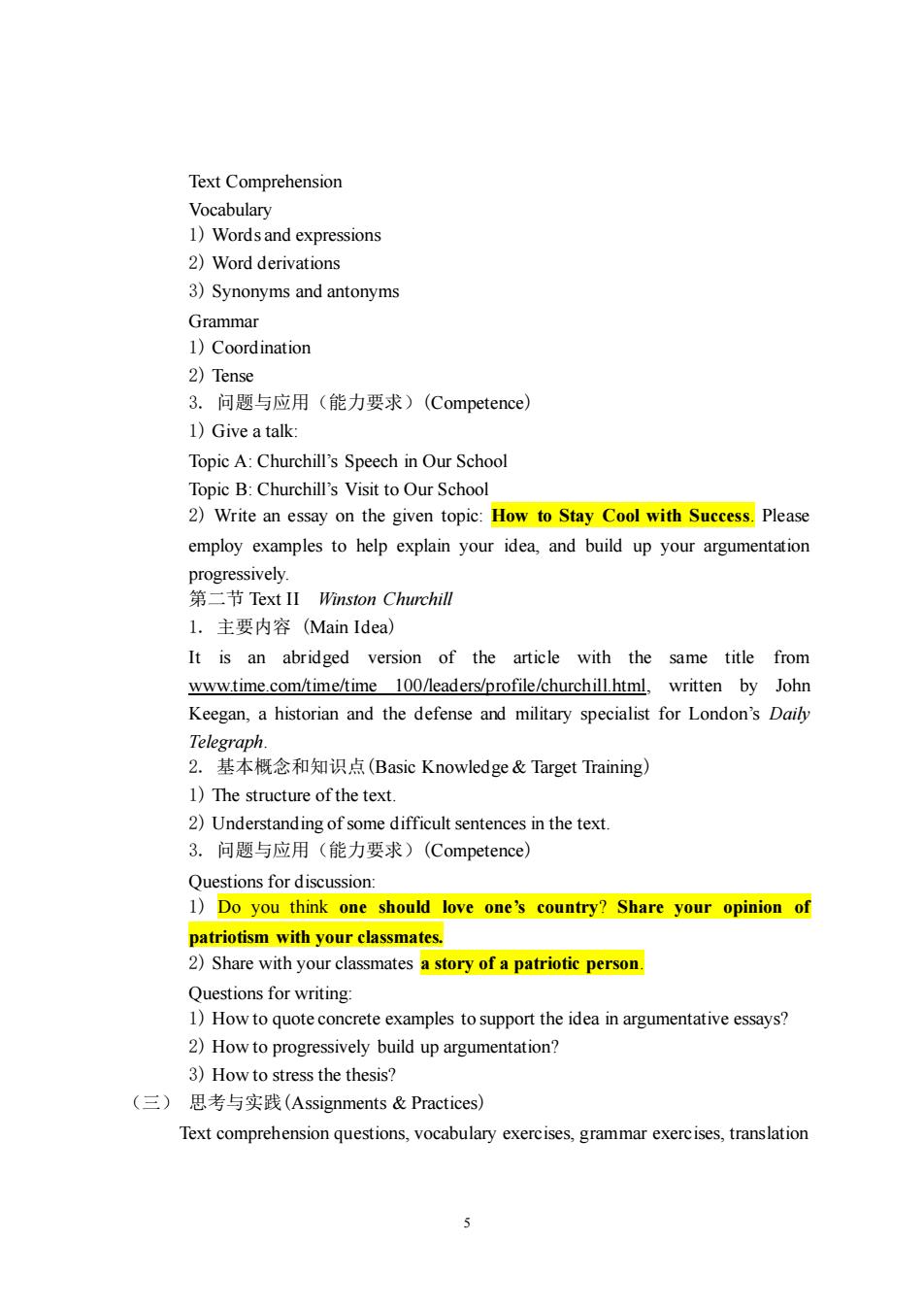
Text comprehension Vocabulary 1)Words and expressions 2)Word derivations 3)Synonyms and antonyms Grammar 1)Coordination 2)Tense 3.问题与应用(能力要求)(Competence) 1)Give a talk: Topic A:Churchill's Speech in Our School Topic B:Churchill's Visit to Our School 2)Write an essay on the given topic:How to Stay Cool with Success.Please employ examples to help explain your idea,and build up your argumentation 第二节Text II Winston Churchill l.主要内容(Main Idea)) It is an abridged version of the article with the same title from wwwtime.com/time/time 100/leaders/profile/churchill.html,written by John Keegan,a historian and the defense and military specialist for London's Daily Telegraph. 2.基本概念和知识点(Basic Knowledge&Target Training) 1)The structure ofthe text 2)Understanding of some difficult sentences in the text. 3.问题与应用(能力要求)(Competence) Questions for discussion 1)Do you think one should love one's country?Share your opinion of patriotism with your classmates. 2)Share with your classmates a story of a patriotic person. Questions for writing: 1)How to quote concrete examples to support the idea in argumentative essays? 2)How to progressively build up argumentation? 3)How to stress the thesis? (三)思考与实践(Assignments&Practices) Text comprehension questions,vocabulary exercises,grammar exercises,translation 5
5 Text Comprehension Vocabulary 1) Words and expressions 2) Word derivations 3) Synonyms and antonyms Grammar 1) Coordination 2) Tense 3. 问题与应用(能力要求)(Competence) 1) Give a talk: Topic A: Churchill’s Speech in Our School Topic B: Churchill’s Visit to Our School 2) Write an essay on the given topic: How to Stay Cool with Success. Please employ examples to help explain your idea, and build up your argumentation progressively. 第二节 Text II Winston Churchill 1. 主要内容 (Main Idea) It is an abridged version of the article with the same title from www.time.com/time/time 100/leaders/profile/churchill.html, written by John Keegan, a historian and the defense and military specialist for London’s Daily Telegraph. 2. 基本概念和知识点(Basic Knowledge & Target Training) 1) The structure of the text. 2) Understanding of some difficult sentences in the text. 3. 问题与应用(能力要求)(Competence) Questions for discussion: 1) Do you think one should love one’s country? Share your opinion of patriotism with your classmates. 2) Share with your classmates a story of a patriotic person. Questions for writing: 1) How to quote concrete examples to support the idea in argumentative essays? 2) How to progressively build up argumentation? 3) How to stress the thesis? (三) 思考与实践(Assignments & Practices) Text comprehension questions, vocabulary exercises, grammar exercises, translation
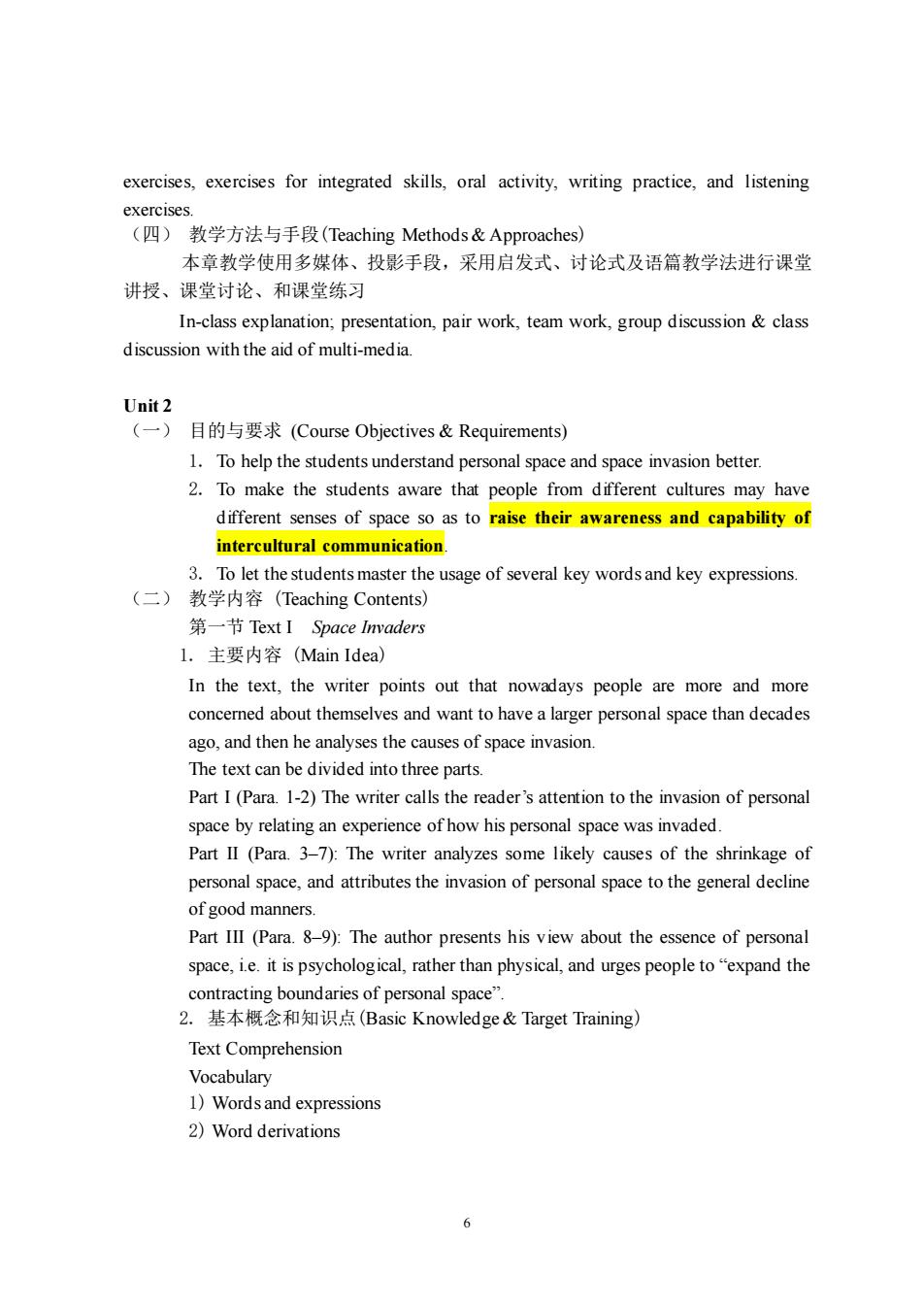
exercises,exercises for integrated skills,oral activity,writing practice,and listening exercises. (四)教学方法与手段(Teaching Methods&Approaches) 本章教学使用多媒体、投影手段,采用启发式、讨论式及语篇教学法进行课堂 讲授、课堂讨论、和课堂练习 In-class explanation;presentation,pair work,team work,group discussion class discussion with the aid of multi-media Unit2 (一)目的与要求(Course Objectives&Requirements) 1.To help the students understand personal space and space invasion better. 2.To make the students aware that people from different cultures may have different senses of space so as to raise their awareness and capability of intercultural communication. 3.To let the students master the usage of several key words and key expressions. (二)教学内容(Teaching Contents) 第-节TextI Space Invaders 1.主要内容(Main Idea) In the text,the writer points out that nowadays people are more and more concemed about themselves and want to have a larger personal space than decades ago,and then he analyses the causes of space invasion. The text can be divided into three parts. Part I(Para.1-2)The writer calls the reader's attention to the invasion of personal space by relating an experience of how his personal space was invaded. Part II (Para.3-7):The writer analyzes some likely causes of the shrinkage of personal space,and attributes the invasion of personal space to the general decline of good manners Part III (Para.89):The author presents his view about the essence of personal space,i.e.it is psychological,rather than physical,and urges people to"expand the contracting boundaries of personal space" 2.基本概念和知识点(Basic Knowledge&Target Training) Text Comprehension Vocabulary 1)Words and expression 2)Word derivations
6 exercises, exercises for integrated skills, oral activity, writing practice, and listening exercises. (四) 教学方法与手段(Teaching Methods & Approaches) 本章教学使用多媒体、投影手段,采用启发式、讨论式及语篇教学法进行课堂 讲授、课堂讨论、和课堂练习 In-class explanation; presentation, pair work, team work, group discussion & class discussion with the aid of multi-media. Unit 2 (一) 目的与要求 (Course Objectives & Requirements) 1. To help the students understand personal space and space invasion better. 2. To make the students aware that people from different cultures may have different senses of space so as to raise their awareness and capability of intercultural communication. 3. To let the students master the usage of several key words and key expressions. (二) 教学内容 (Teaching Contents) 第一节 Text I Space Invaders 1. 主要内容 (Main Idea) In the text, the writer points out that nowadays people are more and more concerned about themselves and want to have a larger personal space than decades ago, and then he analyses the causes of space invasion. The text can be divided into three parts. Part I (Para. 1-2) The writer calls the reader’s attention to the invasion of personal space by relating an experience of how his personal space was invaded. Part II (Para. 3–7): The writer analyzes some likely causes of the shrinkage of personal space, and attributes the invasion of personal space to the general decline of good manners. Part III (Para. 8–9): The author presents his view about the essence of personal space, i.e. it is psychological, rather than physical, and urges people to “expand the contracting boundaries of personal space”. 2. 基本概念和知识点(Basic Knowledge & Target Training) Text Comprehension Vocabulary 1) Words and expressions 2) Word derivations
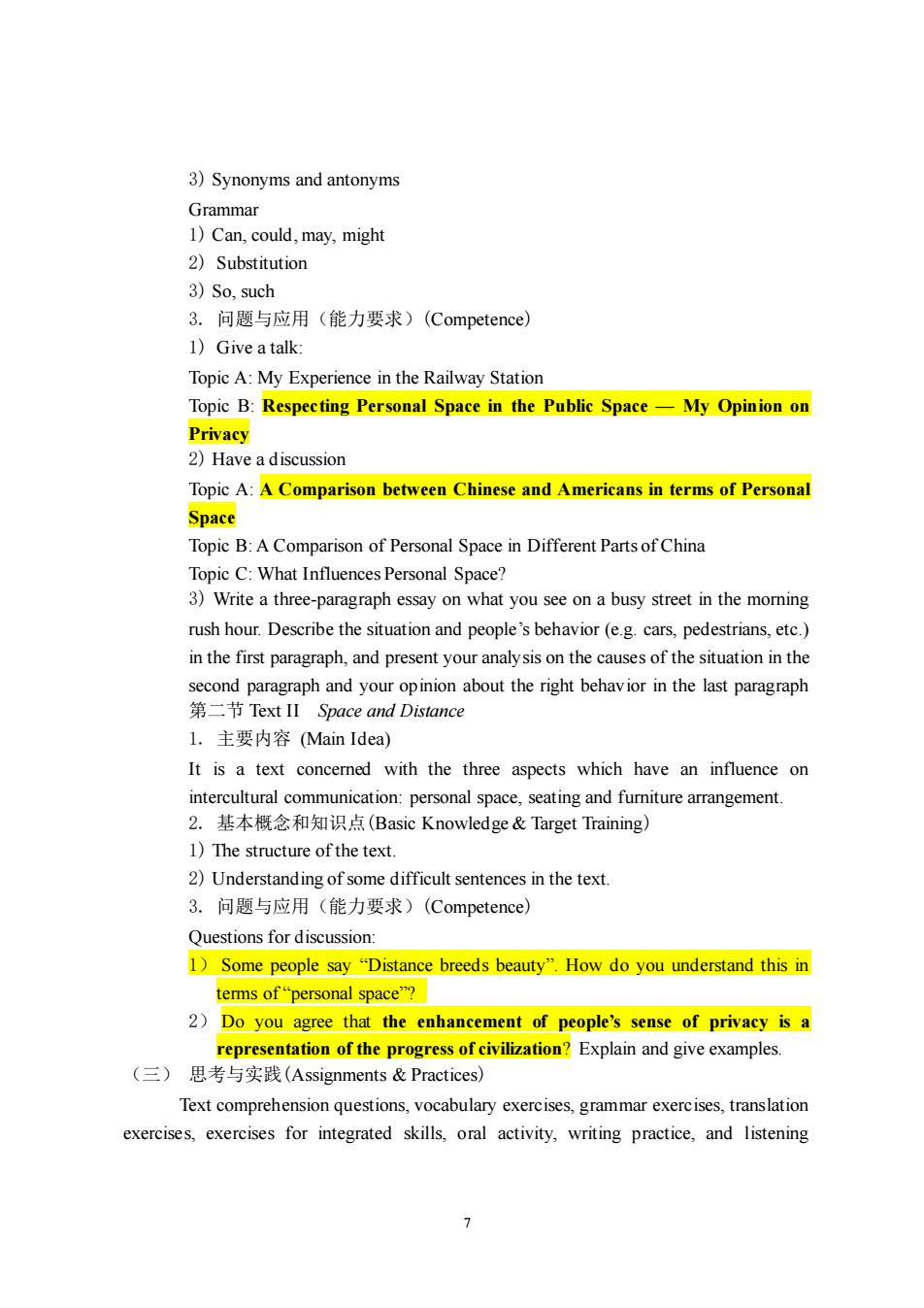
3)Synonyms and antonyms Grammar 1)Can,could,may,might 2)Substitution 3)So.such 3.问题与应用(能力要求)(Competence) l)Give a talk: Topic A:My Experience in the Railway Station Topic B:Respecting Personal Space in the Public Space-My Opinion on Privacy 2)Have a discussion Topic A:A Comparison between Chinese and Americans in terms of Personal Space Topic B:A Comparison of Personal Space in Different Parts of China Topic C:What Influences Personal Space? 3)Write a three-paragraph essay on what you see on a busy street in the morning rush hour.Describe the situation and people's behavior(e.g.cars,pedestrians,etc.) in the first paragraph,and present your analysis on the causes of the situation in the second paragraph and your opinion about the right behavior in the last paragraph 第二节Text II Space and Distance L.主要内容(Main Idea)) It is a text concemned with the three aspects which have an influence on intercultural communication:personal space,seating and furniture arrangement. 2.基本概念和知识点(Basic Knowledge&Target Training) 1)The structure of the text 2)Understanding of some difficult sentences in the text. 3.问题与应用(能力要求)(Competence) Questions for discussion 1Some people say "Distance breeds beauty".How do you understand this in temms of“personal space? 2)Do you agree that the enhancement of people's sense of privacy is a represe ntation of the progress of civilization?Explain and give examples (三)思考与实践(Assignments&Practices) Text comprehension questions,vocabulary exercises,grammar exercises,translation exercises,exercises for integrated skills,oral activity,writing practice,and listening 7
7 3) Synonyms and antonyms Grammar 1) Can, could, may, might 2) Substitution 3) So, such 3. 问题与应用(能力要求)(Competence) 1) Give a talk: Topic A: My Experience in the Railway Station Topic B: Respecting Personal Space in the Public Space — My Opinion on Privacy 2) Have a discussion Topic A: A Comparison between Chinese and Americans in terms of Personal Space Topic B: A Comparison of Personal Space in Different Parts of China Topic C: What Influences Personal Space? 3) Write a three-paragraph essay on what you see on a busy street in the morning rush hour. Describe the situation and people’s behavior (e.g. cars, pedestrians, etc.) in the first paragraph, and present your analysis on the causes of the situation in the second paragraph and your opinion about the right behavior in the last paragraph 第二节 Text II Space and Distance 1. 主要内容 (Main Idea) It is a text concerned with the three aspects which have an influence on intercultural communication: personal space, seating and furniture arrangement. 2. 基本概念和知识点(Basic Knowledge & Target Training) 1) The structure of the text. 2) Understanding of some difficult sentences in the text. 3. 问题与应用(能力要求)(Competence) Questions for discussion: 1) Some people say “Distance breeds beauty”. How do you understand this in terms of “personal space”? 2) Do you agree that the enhancement of people’s sense of privacy is a representation of the progress of civilization? Explain and give examples. (三) 思考与实践(Assignments & Practices) Text comprehension questions, vocabulary exercises, grammar exercises, translation exercises, exercises for integrated skills, oral activity, writing practice, and listening
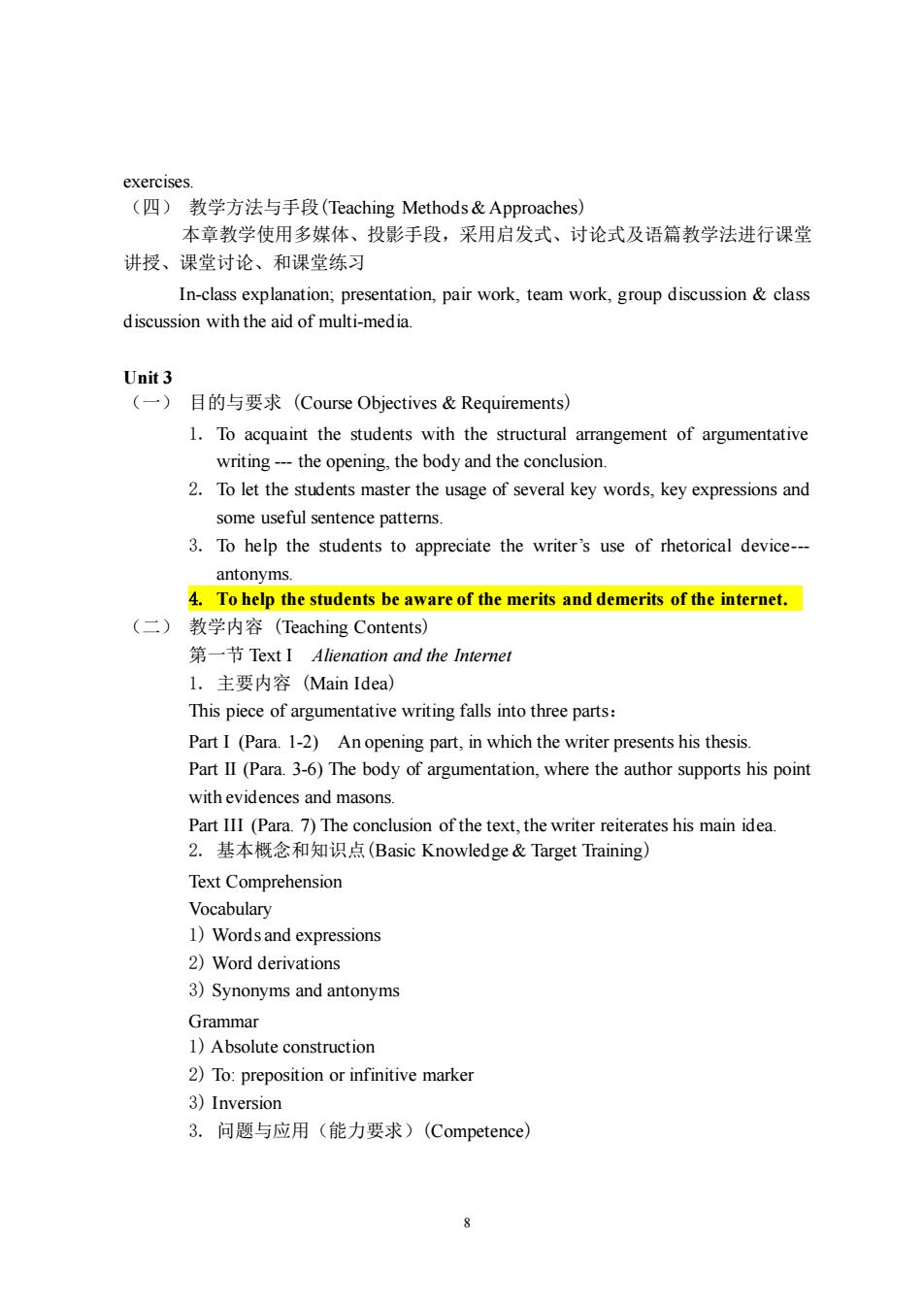
exercises (四)教学方法与手段(Teaching Methods&Approaches) 本章教学使用多媒体、投影手段,采用启发式、讨论式及语篇教学法进行课堂 讲授、课堂讨论、和课堂练习 In-class explanation;presentation,pair work,team work,group discussion&class discussion with the aid of multi-media. Unit3 (一)目的与要求(Course Objectives&Requirements) 1.To acquaint the students with the structural arrangement of argumentative writing-the opening.the body and the conclusion 2.To let the students master the usage of several key words,key expressions and some useful sentence pattems. 3.To help the students to appreciate the writer's use of rhetorical device- antonyms. 4.To help the students be aware of the merits and demerits of the internet. (二) 教学内容(Teaching Contents) 第一节Text I Alienation and the Internet L.主要内容(Main Idea) This piece of argumentative writing falls into three parts: Part I(Para.1-2)Anopening part,in which the writer presents his thesis. Part II (Para.3-6)The body of argumentation,where the author supports his point with evidences and masons. Part III (Para.7)The conclusion of the text,the writer reiterates his main idea. 2.基本概念和知识点(Basi Knowledge&Target Training) Text Comprehension Vocabulary 1)Words and expressions 2)Word derivations 3)Synonyms and antonyms Grammar 1)Absolute construction 2)To:preposition or infinitive marker 3)Inversion 3.问题与应用(能力要求)(Competence)) 8
8 exercises. (四) 教学方法与手段(Teaching Methods & Approaches) 本章教学使用多媒体、投影手段,采用启发式、讨论式及语篇教学法进行课堂 讲授、课堂讨论、和课堂练习 In-class explanation; presentation, pair work, team work, group discussion & class discussion with the aid of multi-media. Unit 3 (一) 目的与要求 (Course Objectives & Requirements) 1. To acquaint the students with the structural arrangement of argumentative writing --- the opening, the body and the conclusion. 2. To let the students master the usage of several key words, key expressions and some useful sentence patterns. 3. To help the students to appreciate the writer’s use of rhetorical device--- antonyms. 4. To help the students be aware of the merits and demerits of the internet. (二) 教学内容 (Teaching Contents) 第一节 Text I Alienation and the Internet 1. 主要内容 (Main Idea) This piece of argumentative writing falls into three parts: Part I (Para. 1-2) An opening part, in which the writer presents his thesis. Part II (Para. 3-6) The body of argumentation, where the author supports his point with evidences and masons. Part III (Para. 7) The conclusion of the text, the writer reiterates his main idea. 2. 基本概念和知识点(Basic Knowledge & Target Training) Text Comprehension Vocabulary 1) Words and expressions 2) Word derivations 3) Synonyms and antonyms Grammar 1) Absolute construction 2) To: preposition or infinitive marker 3) Inversion 3. 问题与应用(能力要求)(Competence)
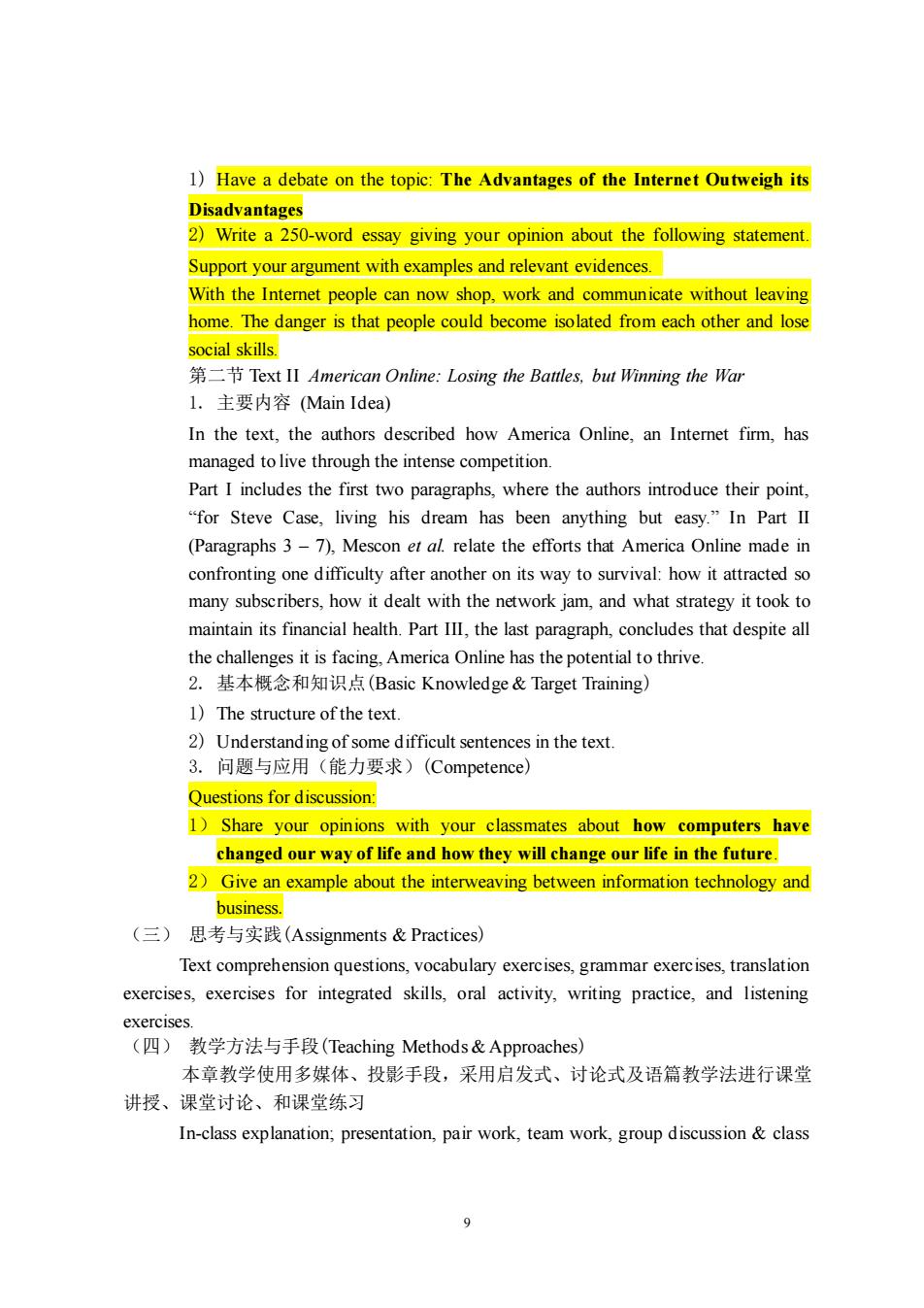
1)Have a debate on the topic:The Advantages of the Internet Outweigh its Disadvantages 2)Write a 250-word essay giving your opinion about the following statement. Support your argument with examples and relevant evidences. With the Intemet people can now shop.work and communicate without leaving home.The danger is that people could become isolated from each other and lose social skills. 第二节Text IⅡAmerican Online:.Losing the Battles,but Winning the War 1.主要内容(Main Idea) In the text,the authors described how America Online,an Internet firm,has managed tolive through the intense competition Part I includes the first two paragraphs,where the authors introduce their point, “for Steve Case,.living his dream has been anything but easy.”In PartⅡ (Paragraphs 3-7),Mescon et al.relate the efforts that America Online made in confronting one difficulty after another on its way to survival:how it attracted so many subscribers.how it dealt with the network jam.and what strategy it took to maintain its financial health.Part Ill,the last paragraph,concludes that despite all the challenges it is facing.America Online has the potential to thrive. 2.基本概念和知识点(Basic Knowledge&Target Training)) 1)The structure ofthe text. 2)Understanding of some difficult sentences in the text. 3.问题与应用(能力要求)(Competence). Questions for discussion: 1)Share your opinions with your classmates about how computers have changed our way of life and how they will change our life in the future. business. (三)思考与实践(Assignments&Practices) Text comprehension questions,vocabulary exercises,grammar exercises,translation exercises,exercises for integrated skills,oral activity,writing practice,and listening exercises. (四)教学方法与手段(Teaching Methods&Approaches) 本章教学使用多媒体、投影手段,采用启发式、讨论式及语篇教学法进行课堂 讲授、课堂讨论、和课堂练习 In-class explanation;presentation,pair work,team work,group discussion&class 9
9 1) Have a debate on the topic: The Advantages of the Internet Outweigh its Disadvantages 2) Write a 250-word essay giving your opinion about the following statement. Support your argument with examples and relevant evidences. With the Internet people can now shop, work and communicate without leaving home. The danger is that people could become isolated from each other and lose social skills. 第二节 Text II American Online: Losing the Battles, but Winning the War 1. 主要内容 (Main Idea) In the text, the authors described how America Online, an Internet firm, has managed to live through the intense competition. Part I includes the first two paragraphs, where the authors introduce their point, “for Steve Case, living his dream has been anything but easy.” In Part II (Paragraphs 3 – 7), Mescon et al. relate the efforts that America Online made in confronting one difficulty after another on its way to survival: how it attracted so many subscribers, how it dealt with the network jam, and what strategy it took to maintain its financial health. Part III, the last paragraph, concludes that despite all the challenges it is facing, America Online has the potential to thrive. 2. 基本概念和知识点(Basic Knowledge & Target Training) 1) The structure of the text. 2) Understanding of some difficult sentences in the text. 3. 问题与应用(能力要求)(Competence) Questions for discussion: 1) Share your opinions with your classmates about how computers have changed our way of life and how they will change our life in the future. 2) Give an example about the interweaving between information technology and business. (三) 思考与实践(Assignments & Practices) Text comprehension questions, vocabulary exercises, grammar exercises, translation exercises, exercises for integrated skills, oral activity, writing practice, and listening exercises. (四) 教学方法与手段(Teaching Methods & Approaches) 本章教学使用多媒体、投影手段,采用启发式、讨论式及语篇教学法进行课堂 讲授、课堂讨论、和课堂练习 In-class explanation; presentation, pair work, team work, group discussion & class
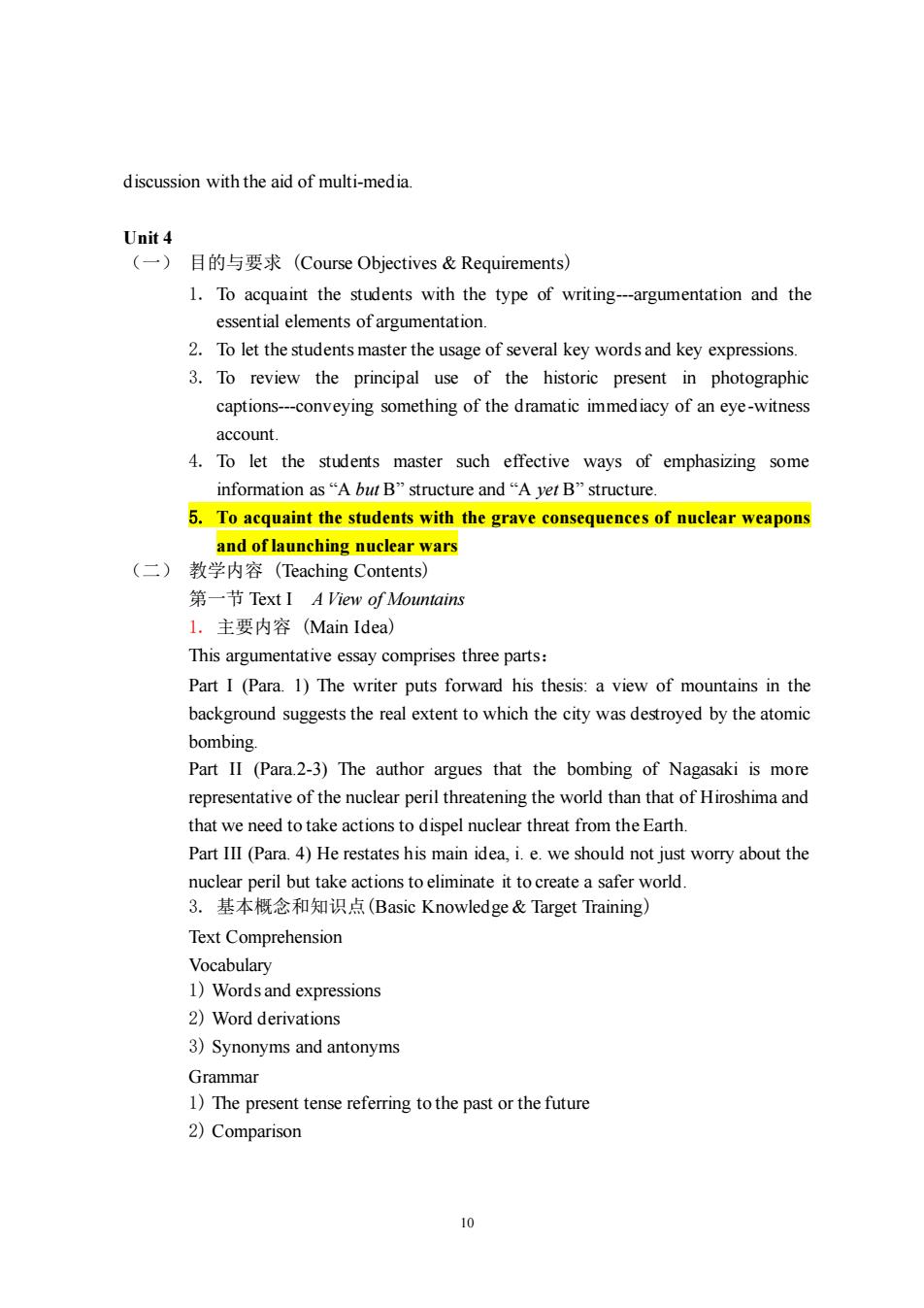
discussion with the aid of multi-media (一)目的与要求(Course Objectives&Requirements) 1.To acquaint the students with the type of writing--argumentation and the essential elements of argumentation. 2.To let the students master the usage of several key words and key expressions. 3.To review the principal use of the historic present in photographic captions--conveying something of the dramatic immediacy of an eye-witness account 4.To let the students master such effective ways of emphasizing some information as“A but B”structure and“A yet B”structure. 5.To acquaint the students with the grave consequences of nuclear weapons and of launching nuclear wars (二)教学内容(Teaching Contents) 第一节Text I A View of Mountains L.主要内容(Main Idea)) This argumentative essay comprises three parts: Part I(Para.1)The writer puts forward his thesis:a view of mountains in the background suggests the real extent to which the city was destroyed by the atomic bombing. Part II (Para.2-3)The author argues that the bombing of Nagasaki is more representative of the nuclear peril threatening the world than that of Hiroshima and that we need to take actions to dispel nuclear threat from the Earth. Part III(Para.4)He restates his main idea,i.e.we should not just worry about the Text Comprehension Vocabulary 1)Words and expressions 2)Word derivations 3)Synonyms and antonyms Grammar 1)The present tense referring to the past or the future 2)Comparison
10 discussion with the aid of multi-media. Unit 4 (一) 目的与要求 (Course Objectives & Requirements) 1. To acquaint the students with the type of writing---argumentation and the essential elements of argumentation. 2. To let the students master the usage of several key words and key expressions. 3. To review the principal use of the historic present in photographic captions---conveying something of the dramatic immediacy of an eye-witness account. 4. To let the students master such effective ways of emphasizing some information as “A but B” structure and “A yet B” structure. 5. To acquaint the students with the grave consequences of nuclear weapons and of launching nuclear wars (二) 教学内容 (Teaching Contents) 第一节 Text I A View of Mountains 1. 主要内容 (Main Idea) This argumentative essay comprises three parts: Part I (Para. 1) The writer puts forward his thesis: a view of mountains in the background suggests the real extent to which the city was destroyed by the atomic bombing. Part II (Para.2-3) The author argues that the bombing of Nagasaki is more representative of the nuclear peril threatening the world than that of Hiroshima and that we need to take actions to dispel nuclear threat from the Earth. Part III (Para. 4) He restates his main idea, i. e. we should not just worry about the nuclear peril but take actions to eliminate it to create a safer world. 3. 基本概念和知识点(Basic Knowledge & Target Training) Text Comprehension Vocabulary 1) Words and expressions 2) Word derivations 3) Synonyms and antonyms Grammar 1) The present tense referring to the past or the future 2) Comparison